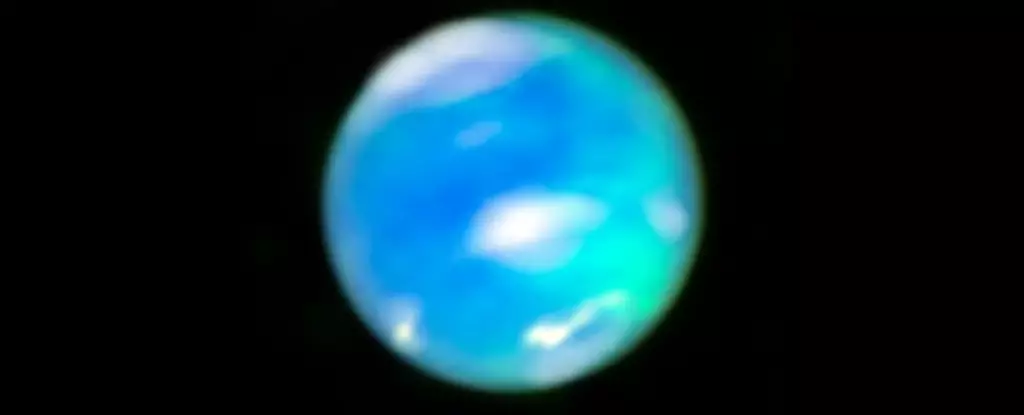After years of speculation and intricate analysis, the enigmatic planet Neptune has finally unveiled its secrets, delighting astronomers and space enthusiasts alike. For the first time, an aurora on this distant, ice-blue world has been documented, showcasing a phenomenon that transcends our understanding of planetary interactions. Utilizing the remarkable capabilities of the James Webb Space Telescope (JWST), this discovery not only enriches our knowledge of Neptune but also of the fundamental cosmic processes that tie together the planets within our Solar System.
A Glimpse into the Auroral World
Auroras are commonly associated with swirling colors in the skies of Earth, a dazzling dance ignited by solar winds colliding with our magnetic field. Yet, the auroras of Neptune burst forth not in brilliant hues as seen on our planet, but in a mesmerizing blue hue emanating from the planet’s grasp on nature’s arcane traits. JWST’s ability to capture near-infrared light has enabled scientists to create detailed images of auroras far from the Sun, providing unprecedented insights into an iconic scientific phenomenon. While auroras on Earth serve as a vibrant public spectacle, Neptune’s auroras reveal a uniqueness colored by the planet’s atmospheric and magnetic idiosyncrasies.
The Cosmic Family of Auroras
This remarkable revelation adds Neptune to an illustrious family of planetary auroras, with each member exhibiting distinct features influenced by its environment and composition. Earth’s famed auroras create a symphony of colors, while Jupiter showcases towering bands of ultraviolet light, visibly more ferocious and powerful. Saturn, Mars, and even Venus have their own depictions of these ethereal displays, each governed by the intricate relationship between their atmospheres and the solar wind.
Interestingly, Mercury presents a peculiar case — lacking an atmosphere of any significance, its auroras manifest as X-ray fluorescence rather than the traditional luminous displays seen elsewhere. The early uncertainty regarding the existence of auroras on Neptune and Uranus was due to their great distances from the Sun; however, old data and newly obtained JWST readings have now effectively validated their existence.
Mapping the Mystery
The methodology behind locating Neptune’s auroras was equally fascinating. The research team, led by astrobiologist Henrik Melin from Northumbria University, meticulously tracked the concentration of the trihydrogen cation (H3+). This positively charged molecule is particularly associated with auroral activities and served as a guiding beacon in their exploratory efforts. Unlike Earth’s auroras, which are concentrated around the poles where solar particles are funneled into the atmosphere, Neptune’s magnetic field directs such interactions toward its equatorial regions — a stark contrast attributed to its chaotic, irregular magnetic configurations.
This unique magnetic setup raises questions about the fundamental mechanics driving planetary interactions in different environments — an essential concept for astrobiology and astrophysics. Understanding how various planets with disparate features respond to solar influences can potentially reshape our perspective on habitability on other celestial bodies.
The Scientific Aftermath and Future Implications
Significantly, this discovery affords astronomers a novel lens to interpret phenomena not only in our celestial neighborhood but also among exoplanets orbiting distant stars. Understanding Neptune’s auroras provides scientists with comparable frameworks for assessing atmospheric characteristics and behaviors on alien worlds. By employing insights drawn from the dynamics of auroras within our Solar System, researchers can better predict possible auroral displays beyond our immediate cosmic surroundings.
Moreover, the implications of revealing Neptune’s auroras extend to refining our comprehension of the planet itself. Data from the JWST suggests that Neptune has been gradually cooling since its last close encounter with Voyager 2 in 1989. Cooler temperatures contribute to dimmer auroras, which explains previous misconceptions surrounding their detectability. The fresh perspective gained from this research will enhance not only the framework of solar interactions on Neptune but also broaden the applicability of auroral studies across the universe.
In this interconnected framework of planetary science, the unveiling of Neptune’s auroras heralds a groundbreaking chapter in our cosmic narrative. As we continue to probe deeper into the mysteries of our celestial realm, Neptune stands as a shining testament to the allure of the unknown, beckoning us to explore further into the interstellar fabric of our universe.

